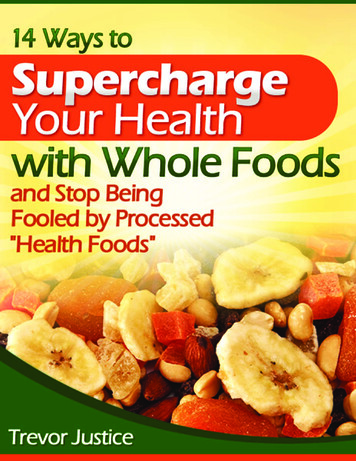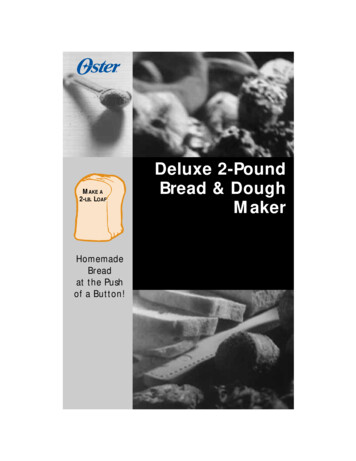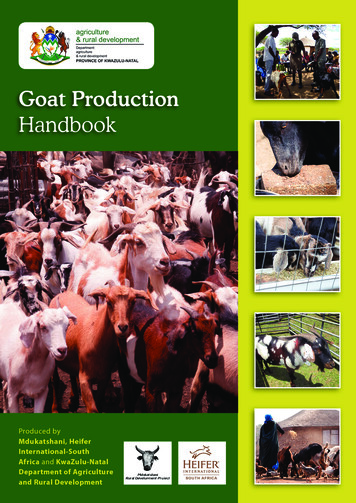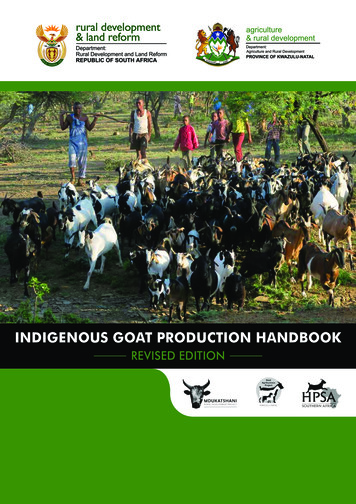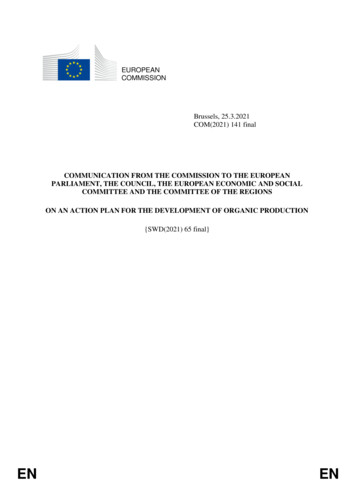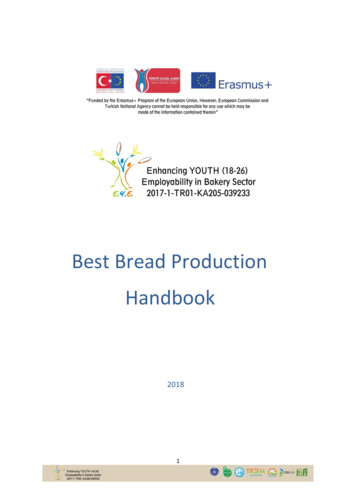
Transcription
Best Bread ProductionHandbook20181
Contents1.A new old story - short introduction in bakery41.1. Traditional baking – things to keep in mind51.2. Baking in our days – new challenges61.3. How to maintain a good balance between old and new72.All stuff we need – raw materials and others2.1. Flours – different cereals and sustainability2.2. Yeast and leaving procedures – how to obtain the best flavors3.What about E-numbers? – main additives used in bakery8910133.1. Flours correction – direct from the mill143.2.Technological additives – role and necessity153.3.How to replace E-numbers194.Dough processing route – first steps of the technological flow214.1.Mixing, fermentation, dividing, final proof - main processes involved234.2. Specific parameters – definitions and importance265.6.From dough to bread – baking steps275.1.Transformations during baking285.2.Ovens types – how to assure the products individuality30Bread cooling316.1. Importance and parameters326.2.The ageing of bread – modifications and prevention332
7.Packaging and shelf life367.1.Keep the product integrity – packaging materials and techniques377.2.Short or long shelf life? – how to manage398.Technological scheme – how to draw it and how to follow it418.1. Estonian bread – typical product technological scheme428.2. Romanian bread - typical product technological scheme438.3.Turkish bread - typical product technological scheme449.Let’s analyze our work – evaluation of bakery products459.1.Pay attention from the beginning – raw materials control469.2.Monitoring the technological flow – phases control479.3.Think as a consumer does – final products control4810.Innovation and new trends4910.1.Research and development role5110.2.Consumer’s needs and expectations53References553
Chapter 11.1. A new old story - short introduction in bakeryThe history of the bakery is parallel to the history of human civilization - thebread could have been one of the first foods processed by man and wascertainly is the first to be produced on a large scale. Even there are no recordsof when the bread was originated, but the bread has been around forthousands of years. Rustic breads consisted of crushed grain, soaked in water,kneaded and letting it fermenting with natural yeasts to be baked. Loaves ofbread were buried as funerary offerings, and have been found, dated at 5,000years old in predynastic Egyptian tombs. Archaeological evidence shows that aquite evolved baking production existed in Egyptian civilization, about 5,000years ago, possibly being the staple food of the laborers working in pyramidsconstruction (the process of making bread in the bakery of Pharaoh isdescribed on the walls of the tomb of Ramses III – fig.1).Figure 1. Bread making process in Egypt, 3,000 B.C(source: http://www.historicalcookingproject.com)In ancient Rome, grain milling and baking the dough into loaves was a wellestablished practice. Before appearing compressed yeast, the seeding systemof dough was made with natural yeast. Natural yeast was the fermentationbase until the seventeenth century when begins the addition of brewer’s yeast.4
But it was not until the mid-nineteenth century when bread began to bemanufactured exclusively with brewer’s yeast. The bread obtained had a bittertaste and the baker had big problems to keep that yeast. The problem wassolved later with first compressed yeasts, which possessed better preservativequalities and greater fermentative power.1.2. Traditional baking – things to keep in mindBefore the use of brewer’s yeast for fermentation stage, a dough formed as amix of water, wheat or rye and raisins, prunes and bran, had been left soakingas a first fermentation. Then, an initial alcoholic fermentation started and aftera few days of cultivation an acidic fermentation triggered. After severalrefreshes, this sourdough was added to the dough. From the latest batch apiece of dough was put away, and after two or three refreshments, spacedeach 4 or 5 hours the natural yeast was obtained. "Dough" ready to use, in aproportion of 30 to 40 kilos dough per 100 kg. flour. The baker had to payspecial attention in the development of this ferment/sourdough, because itdepended on getting good quality bread. At present time, therefore, thefermented dough has lost its basic function of serving as "yeast seeding ", asthis objective is achieved conveniently with the addition of yeast, focusing onother objectives. In a few words we could resume that as biotechnology hasprogressed it is possible to bake without the use of sourdoughs, but this is arelatively recent development. The important issue is that it has been foundthat when you stop using sourdough, bread is not the same. Therefore it isclear that the sourdough has a positive influence on the quality of bread, andbecause it improves the final product, different technologies were developedto find various types of sourdough suitable for the industrial and large scaleproduction. Commercial products are available, both in liquid and powderforms, ready-to-use in the modern baking to improve the taste and flavor ofbread, despite the decreasing of processing time.Besides this, there is a trend in present time to come back to the raw materialsused in traditional bakery, which could bring new nutritional and healthy5
properties to some products - old varieties of grains, various types of flour andso on.Figure 2. Interior of a medieval bakeryMainly the traditional bakery is characterized by a discontinuous process, everystage being effectuated in a specific place and conditions, without evidentconnection between them (fig.2).1.3. Baking in our days – new challengesThe technic and technological progress, the global population continuouslyincreasing, thus the consumption and demands for foods are in an ascendantline, the baking field has undergone huge transformations. For a betterproductivity and a higher products safety all the facilities related to breadproduction were redesigned, and the continuously process have replaced theold ones (fig.3). This is the case for the majority of bakeries, but in the sametime little capacities remain to provide fresh bread in their neighbors. Withoutregards to the size of the bakeries, the main challenges to overcome are thesame:-higher standards for bread safetybetter products quality levelhealthy and nutrition concerns of consumersprolonged shelf –lifea large assortment of productsdifficult to find workforce willing to work in shiftsfind well- trained staff6
Figure 3. Industrial line for bread baked in tins production1.4. How to maintain a good balance between old and newFor the personnel involved in the bakery industry there are permanently somequestions to solve regarding the balance between the old versus newtechnologies with the aim to better answer to the increasing demands of moreconscientious consumers. Thus consumers prefer bread with the taste,appearance and flavor specific to traditional products, but obtained in the saferconditions and with the long shelf-life provided by the new technologies. Allthe staff involved in bakeries have to be well-trained and prepared to deal withsuch problems; the right knowledge of the chemical, physical and biochemicalprocesses involved in bakery technological flow, the influence of newoperations and devices on the whole production , play a crucial role in themanagement of the main problems.7
Chapter 2All stuff we need – raw materials and othersBasically bakery products are manufactured from: flour: wheat, rye, barley, quinoa;sugar and sweeteners;milk products: whole or skimmed milk, butter, whey;fats and oils;yeast or baking powder, jelly, dry fruits, various essences,flavoring, etc.As sweeteners in bread making could be used granulated sugar, dextrosepowder, liquid sucrose - syrup, dextrose - syrup, mixtures of syrups - whichinclude combinations of sugar, dextrose, syrup obtained by converting somepolysaccharides into simple sugars, honey, brown sugar (residual molassessugar).The sugars listed above contribute to:-confer taste, flavor and aroma characteristic to each source,provide feed for yeast cells,enhance the color of the finished product ,soak the consistency of the dough.Milk and dairy products category includes: whole milk or skimmed milk,skimmed-milk powder, condensed milk, butter, sweet condensed whey andwhey mixes. Milk products contribute to the aroma, nutritional qualities,prolongation of fermentation, improvement of crust color (due to lactose),water absorption (due to proteins) and texture of bakery products.Fats and oils are essential raw materials for the bakery industry - commercialoils and fats are mainly coming from plants (fruits and seeds) and animals (milkfat, tissues) and can be divided in five categories depending on their origin:- vegetable oils are liquid and are specific to tempered areas: soya oil is the principal oil in terms of volume produced globally, rapeseed,sunflower and corn are also oils of great economic interest8
- tropical oils are mostly coming from Malaysia and Indonesia - palmand palm kernel oils are solid fats coming from the flesh and thekernel the same fruit, and coconut oil- exotic oils are also grown in tropical areas of Africa and Indonesia,with typical representatives Illipe butter and Shea butter- animal fats are mainly coming from mammals (milk fat, lard andtallow). Fish oil is also important in some areas. Fish oils are veryprone to oxidation- other oils are locally produced and in smaller volumes but areimportant mainly for a nutritional point of view. Olive oil is widelyknown; also flaxseed oil has turn to be of great nutritional interest asa source of ω-3 fatty acids.The following effects have been witnessed by increased fat incorporation inbread: different crumb structure, softer bite, shelf life extension by slowingthe staling process, softer crust - when more than 3 % flour weight fat is used,improving slicing of finished product -a minimum of 1 % is recommended forsliceable bread, gases expansion and improved handling of dough, improvedpalatability.2.1 Flours – different cereals and sustainabilityCereals - a family of Gramineae, grown for their edible grains, composed ofendosperm, germ and bran. The most used cereals in bread making are wheat,rye, triticale, barley, oats, maize, sorghum, millet and rice; in recent years anincreasing use of pseudo cereals, with similar properties but belonging to otherfamilies, as buckwheat, quinoa and amaranth are noticed. The type ofcereal/pseudo cereal is important for the nutritional value and for the glutencontent – in the case of gluten free products. Wheat varieties suitable forproduction are Triticum durum wheat for bread and pasta and Triticumaestivum wheat with bakery attributes. There are some varieties of wheat:hard red, soft white and hard red (fig. 4). New trends are dictated by therationale for increasing nutritional value and in this approach ancient varietiesare involved: Triticum turgidum spp turanicum - commercial name kamut andTriticum dicoccum - farro – with superior nutritional properties. Sustainability9
requires focusing on eco-friendly crops, reducing the water usage in the cerealprocessing, the use of various cereals and their varieties.Figure 4. Different flours from various types of wheat(source: melskitchencafe.com)An important fact for bakers to be aware is that of the gluten intolerance andceliac disease; currently, the only treatment for is lifelong adherence to a strictgluten-free diet, people must avoid foods with wheat, rye and barley, such asbread and beer. For them the wheat flour had to be replace by rice, oat flour,or other flours that do not develop gluten.2.2. Yeast and leaving procedures – how to obtain the best flavorsYeast is a cell biomass of the genus Saccharomyces cerevisiae, capable of sugarfermentation process in the dough, being used as a biological agent in themanufacture of bread, bakery products and pastry; it is responsible for theproduction of CO2, acids and alcohols during fermentation; acids and alcoholsresulted during fermentation influence the gluten fading and this allows easierdough processing during manufacture. The main types of yeast used are thecompressed yeast (high humidity, can be added as such in dough or maybe insuspension) and the active dry yeast (shows much less moisture thancompressed yeast); the active dry yeast must be hydrated with water at atemperature of 32 - 38 C (fig.5).10
Figure 5.Compressed and dry yeast (source: internet)Sourdoughs with baking yeast – some examples are poolish, biga and sponge(fig.6).The poolish is made with water, flour and pressed yeast which, except forminor variations, is achieved with the proportion of 1 liter of water perkilogram of flour; the result is a composition quite liquid.Biga is a solid ferment, originary from Italy - the water level will be 45%-50%,therefore a lower hydratation than poolish, which also contains yeast (0,5-1%);the fermentation time is between 12 and 18 hours.The sponge - the principles of preparing a sponge are similar to thepreparation of a sourdough; the fundamental difference is that the sourdoughincorporates all of the ingredients of the formulation, while the sponge is madewith a part approximately between 1/3 and 1/4 of the flour .PoolishBigaFigure 6. Sourdoughs with baking yeast11Sponge
If we consider the definition of sourdough in the strictest sense, should bedefined as the mass of flour made from wheat or rye fundamentally, water (5055%) and a small amount of salt (0.5-1%). This mass is maintained at roomtemperature (25 C) in such a way that promotes the growth of microbial floraand thus favoring the various fermentations that occur in the mass. If thetemperature is greater would be enhanced lactic and butyric fermentations.Another sourdough definition according to Katina (2005) - a process in whichflour and water (and other ingredients) are fermented with microbesoriginating from preceding sourdough, commercial starter culture, bakeryequipment or from flour.Spontaneous dough fermentation starts by mixing flour and water withoutadding a starter culture or portion of a preceding sourdough (mother dough).The effect and mechanisms of sourdough fermentation are complex andnumerous, a lot of changes occur in the flour and dough matrix – as thebiochemical reactions presented in fig.7.Figure 7. Biochemical changes in dough12
Chapter 3What about E-numbers? – main additives used in bakeryConsumers often don’t trust what they see on the food packages- recentstudies reveal a consumer need to build trust and to have ingredientsinformation on the naturalness of products, and a global demand for natural,healthy food with a clear, clean front-of-pack claim. But what exactly doconsumers understand by ‘naturalness’ in relation to packaged/conveniencefood products? Here’s what most of them said: 75%: Natural food should contain no additives 72%: Packaged food can be natural 64%: Natural and healthy food are the sameNatural no artificial colours - When asked about the meaning of ‘natural’food, the top answer worldwide was a lack of artificial colours, followed by nopreservatives or artificial flavours. E number - any of a series of numbers withthe prefix E indicating a specific food additive recognized by the EuropeanUnion and used in some foods and drinks to improve their flavour or colour orto make them last longer. In the European legislation for every E number thereare specified the maximum levels of use for every cathegory of food in which isalowed a certain additive.Why do we need improving agents? A lot of reasons leads to the use ofadditives in bakery -here below are listed some of them:-to facilitate the technological processto modify product characteristicsto improve volume, texture and shelf-lifeto use more economical ingredientsto add valueAny ingredient which we add to improve the baking potential of flour may becalled an 'improver'. Different processes have different flours and varyingoptimum improver formulations. Improvers of one form or another have beenused by bakers for over a hundred years so it is wrong to think of them as onlyapplied to modern bread making processes. Today the products we call13
improvers are a mixture of a number of different materials that are alsoconsidered under the general heading of 'functional ingredients'. Modernimprovers formulations are matched to different ingredients, products andprocesses so that substituting one improver for another can have seriouslyadverse effects on final product quality. Improvers dosage levels are alsotailored to specific ingredients and process combinations and in addition to thequality complications in some cases there may be legal implications involved inswitching improvers with the possibility for non-permitted ingredients makingtheir way into some breads or maximum levels of addition being exceeded.3.1. Flours correction – direct from the millThere are two main aspects regarding the use of improvers in bread making,due to type of the bakery. For the big companies, with large automaticproduction lines, it is possible to add in a controlled way all the ingredients andadditives, adequately weight and dosed by specialized devices. Therefore insuch facilities the bakers could realize by themselves the mixture they need,starting from singular additives, making their own recipes of improvers,tailored for different type of products. In small bakeries it is quite difficult forthe bakers to manage the mixture of such small quantities of additives for eachbatch, then it is more convenient for them to purchase from the suppliers flourwhich is already corrected (with ascorbic acid, some enzymes, emulsifiers, etc.)or more, the final products they need – fig. 8.Figure 8. Flours for different applications: bio-bread, rye bread, pastryMany mills are selling flours for different purposes – on the technological flowof the flour milling all the special additives tailored for a special product are14
added carefully weight and the final product is designated to a certain type ofbakery product: bread, cake, croissant, cookies and so on.3.2. Technological additives – role and necessityMain types of improving agents:Oxidising agents. The role of oxidants in bread making systems is that ofimproving the gas retention abilities of the dough through better glutendevelopment. With the addition of suitable oxidizing materials to the dough wecan reduce the development time for doughs from many hours to less than 10minutes and achieve most of the changes in the mixer. If we use a high speedmixer we can achieve full dough development in less than 5 minutes. Thebenefits of oxidizing agents have been known for over 50 years and manydifferent types have been, and are being used around the world. Slow actingones such as potassium bromate have been used widely and were commonthroughout Europe. The faster acting ones such as potassium iodate, calciumiodate, and azodicarbonamide are more widely used in USA. However with agreater awareness of food additives by the general population, and a greaterunderstanding of their function, a number of changes to legislation on Europehave been made with the result that we are left with ascorbic acid (or VitaminC or E 300) as the sole oxidizing agent for use in the baking industry. At presentthe level of use is quantum satis use as much as required. These oxidizingagents are commonly added as part of the bread improver, but they can also beadded to flours by the miller. Bakers need to be aware that they do not overdose bread dough by adding oxidizing agents from several sources.Reducing agents. Reducing agents make dough more extensible. They aredeliberately added to 'weaken' structure in specific products. The majormaterial used in bread dough is an amino acid known as L-cysteine. It can onlybe used at low levels in improvers but by reducing dough resistance todeformation it helps in molding and shape forming, such as rolls and baps,without structural damage. L-cysteine can also be used in pan breads at lowlevels where its ability to reduce resistance can help reduce streaking causedby molding faults. Other ingredients such as deactivated yeast and proteaseshave a similar effect. Reducing agents soften dough by breaking the cross-linksbetween amino acid chains in the gluten network rather than by breaking the15
chains themselves. This reaction is finite and so the process is inherently morecontrollable than that using enzymes. A wide range of recipes use thistechnology and reducing agents are sometimes used in conjunction withenzymes.Emulsifiers. Emulsifier is a general term we use to describe ingredients whichare able to assist in the mixing together of two dissimilar materials. A range ofemulsifiers may be added to bread to improve its quality, each one actingslightly differently and having its own special effects. We will briefly considersome of them:- Glyceryl monostearate GMS – has a softening, anti – staling effect- Diacetyl esters of tartric acid DATEM – gives better bread volume,not permitted in all countries- SSL sodium stearoyl lactylate / CSL calcium stearoyl lactylate –affective but expensive- Lecithin – natural but less effectiveStarch complexing agents, emulsifiers, have been used as anti-staling agents formany years (DATEM, SSL/CSL, GMS) to reduce the apparent staling of thebread. Emulsifiers complex with the amylose and inhibit the rate of starchcrystallization.Stage of processingMixingProvingImproved machinability Better gas retentionShorter fermentationBakingShelf-lifeBetter gas retentionImprove softnessBetter crumb structureLonger shelf-lifeGreater shock toleranceFigure 9. Effect of emulsifiers during bread processing stages16
Hydrophilic – Lipophilic Balance , HLB is a system of classifyingsurfactants/emulsifiers by how much water-loving or fat-loving character themolecules possess, on a scale of 0 – 20; some examples: oleic acid 1.0, monoand diglycerides 2.8, DATEM 7 – 8, SSL 10.0. In addition to single emulsifiersystems, the use of multi-emulsifier gels in cake making is quite widespread,because mixtures of emulsifiers tend to produce better results than individualmaterials, and a wider range of HLB can be covered. Using polyglycerol esters,sorbitan esters or propylene glycol esters in conjunction with GMS can givefurther improvements.Enzymes. Enzymes are biological catalysts – all known enzymes are proteins.They are large molecules made up of chains of amino acids linked together bypeptide bonds. Enzymes active materials have assumed a greater importance inimprover formulations over recent years. Factors affecting enzyme activity are:- temperature- pH- concentration of substrate- inhibitors.Malted barley and wheat flours, often called diastatic malt flour, have been andare still used as an improver by bakers to give better gas retention and otherbenefits in doughs. The traditional role for malted barley flour was to improvegas production in long fermented doughs but today with our more rapidlyprocessed doughs this function is largely irrelevant. Soya flour has been used asa bread improver for many years. It contains lipoxygenase which ‘bleaches’ thenatural pigments in flour to create whiter bread. Other enzyme active materialshave assumed a greater importance in improver formulations. In 1996 the useof enzymes in bread was 'de-regulated' - this means that we can use a muchwider range of enzymes than before, provided they have been shown to besafe for use and human consumption. This will allow the baking industry tomake even greater use of the special properties of enzymes for improvingdough performance and bread quality. The main enzymes in bread arepresented in fig.10.17
Figure 10. Enzymes in breadCereal α-amylase is naturally present in flour. It breaks the starch into simplesugars to feed the young plant. Levels will vary depending on the quality of thewheat and the weather conditions during harvest. Cereal α -amylase can be abeneficial bread improver, but at high levels can cause stickiness, mostnoticeably in sandwich breads; the levels are measured in seconds usingHagberg Falling Number (HFN), where 60s is a very high level and 450s is a verylow level. Flour millers control the level in flour by blending the wheats. Theterm alpha-amylase is used to describe a range of enzymes, which are capableof breaking down damaged starch granules into materials known as dextrinsand in combination with beta-amylase they will produce maltose. Alpha andbeta-amylase work in combination. Beta-amylase attacks the ends of theamylose and amylopectin chains breaking off individual maltose sugarmolecules. Most wheat flours contain adequate levels of beta-amylase so it isthe alpha-amylase that controls the reaction. Additions of alpha-amylase todoughs via improvers and even in flour mills are preferred in the fungal ratherthat the cereal form. This is because the fungal form is inactivated at lowertemperatures in the baking process and reduces the risk of the formation ofhigh levels of sticky dextrins. Excess cereal α- amylase reduces bread quality.Cereal alpha-amylase is produced during the growing cycle and can achievequite high levels if the period around harvesting is wet. The dextrins which areproduced by the action of alpha-amylase on damaged starch are sticky and iftheir level is high enough in the finished bread they build up on the slicerblades and can reduce their efficiency to such an extent that loaves willcollapse.The other widely used enzyme is hemicellulase, also known as pentosanase andxylanase. This was added to the list of permitted enzymes in 1996 and hasalready achieved widespread use. They react with a complex group of flour18
components we call pentosanes which are present in white flour at levels ofaround 2% of the total flour weight. The significance of the pentosanes indough structure becomes apparent if one examines the distribution of water inbread dough. Although pentosanes represent only about 2% of the total flourby weight, they bind roughly ten times their own weight in water.Hemicellulases help to increase volume, improve dough handling but little orno anti-ferming effect – the overall mechanism is probably similar to that forthe amylases, enhancing gas retention and delaying the setting point of thebread in the oven.Gums. Xanthan gum, Guar Gum are water binding agents. Bread softness canbe influenced by increasing the water content of the crumb, therefore moisturein dough can be increased (2-3%). For the same purpose it could be used alsostronger flours which have higher water absorption and hydrocolloids. Butthere are some problems regarding the use of gums:- water being a non-structural ingredient can lead to less volume- increasing water can increase water activity and reduce mold-freeshelf-life.3.3. How to replace E-numbersMain chemical preservatives used in bread making - weak organic acids such aspropionic, benzoic, and sorbic are used to suppress the growth ofmicroorganisms and to lengthen usable life of bakery products.Propionic acid and derivates have action against molds, yeasts and somebacteria (inhibits Bacillus Mesentericus – the bacterium that causes rope inbread); propionic acid and calcium propionate are usually employed atconcentrations of 0.1 and 0.2 per cent respectively. At these levels, molds canbe inhibited for 2 days or more and the formation of rope can be prevented.Higher amounts of propionates are necessary to achieve a sufficient preservingaction, but these concentrations give the bread a distinct odor.Sorbic acid has activity mainly against yeast and molds, is effective to controlmold growth in bakery products at level of 0.125% to 0.3% and is sometimes19
used in combination with propionates to suppress their bad sensory propertiesand to gain a broader spectrum and more effectiveness against breaddeteriorating micro-organisms. The residual taste is less than otherpreservatives, but it has an adverse effect on yeast activity and thus on doughrheology, producing a serious reduction in loaf volume and making doughsticky and difficult to process.In order to avoid the use of these chemical preservation substances, lactic acidbacteria (LAB) are recommended as bio-preservation organisms - inhibit moldgrowth in bakery. Bio-preservative means the use of microorganisms and theirmetabolites to prevent spoilage and to extend the shelf life of foods (fig.11).Figure 11. Influence of acid lactic bacteria (LAB)Another example for replacing chemical additives is the use the effect of fungalalpha-amylase FAA on loaf height during baking. The mechanism by whichthese improvements are obtained: increased oven spring is due to the action offungal alpha-amylase on starch in the loaf (the temperature being 55 to 60 Cwhich lowers dough viscosity). Observations on doughs during baking showthat this allows them to continue to expand later on into the baking process –fig. 12.20
Figure 12. Effect of FAA during baking (Campden BRI)Chapter 4Dough processing route – first steps of the technological flowFlour, water and yeast or others ingredients (as presented in chapter 2.3) aremixed, to obtain the dough; after the bulk dough fermentation is following: theoperation of dividing in smaller pieces, the shaping of dough pieces in thedesired final product form, and the final proof step. For traditional breadmaking, after mixing, the dough must be fermented for a period of time (couldbe 2/3/4 hours – depends on the technology type) before final processing.During this period of time occurs a significant contribution towards glutendevelopment. If an oxidizing agent is used, the gluten is developed in the mixer,saving a considerable amount of time. The use of ascorbic acid in bread makingis not as straightforward as other former permitted oxidants. Ascorbic acid canonly function as an oxidizing agent in dough after it has been itself oxidized toan
polysaccharides into simple sugars, honey, brown sugar (residual molasses sugar).The sugars listed above contribute to: - confer taste, flavor and aroma characteristic to each source, - provide feed for yeast cells, -
